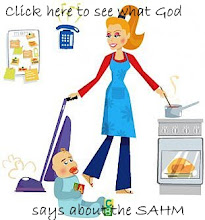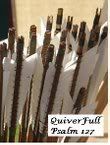I am totally disgusted by how people view and speak of the Dugger family. Yes, having nineteen children is extraordinary but really, must they act like Michelle's fertility is a personal affront against them?
Knowing that is God himself who opens and closes the womb (Gen. 20:18--The Lord closed all the wombs of household of Abimelech Gen. 29:31--The Lord opened Leah's womb Gen. 30:22--The Lord opened Rachel's womb 1 Sam. 1:5--The Lord closed Hannah's womb 1 Sam. 1:6--The Lord closed Hannah's womb), and that God alone makes and forms babies (Psalm 139:13-"For You formed my inward parts; You wove me in my mother's womb." Isa. 44:2-"Thus says the Lord who made you and formed you from the womb…" ) we know that the Duggers are blessed (Psalm 127:3-5 Behold, children are a heritage from the Lord, the fruit of the womb a reward. Like arrows in the hand of a warrior are the children of one's youth. Blessed is the man who fills his quiver with them! He shall not be put to shame when he speaks with his enemies in the gate. - John 16:21 When a woman is giving birth, she has sorrow because her hour has come, but when she has delivered the baby, she no longer remembers the anguish, for joy that a human being has been born into the world. (Am I preaching to the choir here?:)
But, you know, I'd never considered the further foolishness that these naysayers exhibit - at their own expense. Read on in this essay by Jonathan Last to find out what I am talking about:
By
JONATHAN V. LASTJim Bob and Michelle Duggar made headlines recently when the Arkansas couple announced that they are expecting their 19th child. The news about the reality-show stars was met with quiet condescension by polite society and impolite mockery in the trendier parts of the Internet. The dirty jokes write themselves.
Yes, the Duggars are an easy target: They have taken the idea of a large family and given it an exponential boost. And their lives are not exactly filled with suburban glamour, fancy college degrees or evenings at home reading aloud from collections of symbolist verse. The family tends toward plain clothes, warehouse-club portions and the New Testament. And yet the discomfort with the Duggars is not merely an expression of class snobbery. It has partly to do with their hyperfertility. There is a creeping anti-natalism in America that has made having large families a radical act.
Even by historical standards, the Duggars' soon-to-be-19 kids are exceptional. In 1800 the American fertility rate—that is, the number of children born to an average woman in her lifetime—was 7.04 for whites and 7.90 for blacks. (The first census was taken in 1790, and the numbers for the races were tabulated separately.) Over the years, the fertility rate trended inexorably downward. Today the average American woman has only 2.09 children, just a hair beneath the replacement rate of 2.1. The rate for Michelle Duggar's demographic group, non-Hispanic whites, is just 1.85. In 1800, the Duggars would have been odd. By today's standards, they seem positively freakish.
There are scores of reasons for society's decreased fertility. Better medical care reduced infant mortality. In 1850 more than one in five children died in infancy; today that number is just a little over one in 166. With more babies surviving, families needed fewer births to achieve their desired family size. Effective birth control reduced the number of unwanted pregnancies. And, beginning in 1974, widespread access to abortion reduced the number of unwanted pregnancies that were brought to term. Forty-eight million abortions have been performed in America since Roe v. Wade; for perspective, the entire baby-boom generation comprises 75 million people.
There is a panoply of other pressures on fertility, ranging from delayed age of first marriage to car-seat laws (few vehicles can accommodate more than three child-safety seats). But a big part of the story is economics.
In agricultural societies, including that of early 19th-century America, children were of vital economic importance. They provided free labor in the family business and then, in adulthood, care for their elderly parents. They don't perform either of these functions today. Toward the end of the 19th century, industrialization pulled children out of the work force, limiting the contributions they could make to the family. Then Social Security, and later Medicare, began to give to the state the responsibilities that children once had for the financial care of aging parents.
Whatever its merits, the welfare state is a disincentive to childbearing. Each generation of workers pays for the retirement benefits of the generation ahead of it. The system is powered by babies, who grow up to become productive little FICA contributors. But even if you never have children, someone else's kid will eventually pay for your Social Security benefits.
Even as economic incentives for childbearing have diminished, costs have grown. The welfare state required an enormous new tax burden, for instance. When Social Security was first instituted, in 1937, only 1% of earnings up to $3,000 were taxed. Today Social Security and Medicare eat up 7.65% of earnings up to $106,800. According to a study by the Tax Foundation, the median American family in 1955 paid 17.3% of its income in taxes. By 1998, the median two-earner family paid 40.9%. All of which makes family formation much harder. As demographer Phillip Longman observes, young white men since the 1970s have seen a 40% decline in income relative to their fathers—for young black men the figure is 60%.
While the government started taking more of a family's money, the expense of raising a child shot to the moon. The Agriculture Department estimates that the costs of raising a child from birth to age 18—that is, clothes, food, health care—averaged $207,800 in 2007. In real dollars, that's a 15% increase since 1960. But the department's numbers leave out three big-ticket items: child care, college tuition and forgone salaries.
The National Association of Child Care Resource and Referral Agencies reports that in 2008 the average cost of a full-time nanny was $9,630; the average cost of full-time day care was $14,591. That's as much as a year at college. The average cost of state-university tuition, along with room and board, is now $14,333. Private colleges average a good deal more— $34,132. But what's really striking is the rate of increase. During the past 35 years, the real-dollar cost of college has increased by 1,000%. That's not a misprint.
Finally, there is the opportunity cost of a parent not working. Every family's situation is different, but demographer Phillip Longman gives us an illustrative example: If a parent making $45,000 a year stays home with a child until the child begins school, and then returns to work part time until the child graduates from high school, she is forgoing more than $800,000 in lost wages (counting normal inflation and raises).
When you add it all up, it's not uncommon for a single child to cost a normal, middle-class family something like $1.1 million, from birth through the undergrad years. To get some perspective, the median price of a home in 2008 was $180,100. It is commonly said that buying a house is the biggest purchase most Americans will ever make. Having a baby is like buying six houses. Except that they don't increase in value, you can't sell them and after 16 years they'll probably say they hate you.
To be sure, the Duggars have experienced some economies of scale with their soon-to-be 19 bundles of joy. The marginal cost of each additional child is reduced but still nontrivial. Even if none of the Duggars require child care or have to pay for college and Mrs. Duggar never forgoes outside income, the total expenditures will probably be north of $1 million.
The Duggars have mortgaged their financial futures for their children. Yet we're the ones who will benefit. In 1940 there were 160 workers paying the tab for each person collecting Social Security. By 2006, there were just 3.3 workers supporting each pensioner. The Social Security Administration estimates that by 2034, there will be only 2.1 workers for each person collecting a government retirement check.
In an era when it is rare for a bourgeois couple to have even three children, the Duggars are helping subsidize our retirement at considerable costs to themselves. Instead of mocking them, we ought to thank them.—Mr. Last is a Phillips Foundation Fellow working on a book called "America's One-Child Policy."

 Maybe I've been in denial, but it seems to me it was summer up until today.
Maybe I've been in denial, but it seems to me it was summer up until today.














 Buying Spices from the Bulk Bins, I was pleasantly surprised to find over 50 varieties of spices in their bulk food section, and was even more pleased when I saw the prices. I decided to compare the price of spices from the bulk section with those you can buy packaged off the shelf.The price differential was so large I even went back to double-check if I recorded the prices correctly. The reason spices from the bulk bin work out so much cheaper is because you're not paying for the expensive packaging. Many of the off-the-shelf spices come packaged in glass bottles, but even those that just come in simple plastic containers cost significantly more than buying spices from the bulk bins. If you wanted to you could go out and buy little spice containers at a dollar store for fifty cents each and still come in at under half the price of the off-the-shelf spices.I'm sure the spices at Costco and Sam's Club are significantly cheaper per oz. than the little bottles you buy off-the-shelf, but you have to buy in much larger quantities than you may otherwise need. For many spices I find I only use 6-8 oz of a particular spice a year. Spices can spoil quickly making buying the 27 oz. containers from Costco infeasible for me.
Buying Spices from the Bulk Bins, I was pleasantly surprised to find over 50 varieties of spices in their bulk food section, and was even more pleased when I saw the prices. I decided to compare the price of spices from the bulk section with those you can buy packaged off the shelf.The price differential was so large I even went back to double-check if I recorded the prices correctly. The reason spices from the bulk bin work out so much cheaper is because you're not paying for the expensive packaging. Many of the off-the-shelf spices come packaged in glass bottles, but even those that just come in simple plastic containers cost significantly more than buying spices from the bulk bins. If you wanted to you could go out and buy little spice containers at a dollar store for fifty cents each and still come in at under half the price of the off-the-shelf spices.I'm sure the spices at Costco and Sam's Club are significantly cheaper per oz. than the little bottles you buy off-the-shelf, but you have to buy in much larger quantities than you may otherwise need. For many spices I find I only use 6-8 oz of a particular spice a year. Spices can spoil quickly making buying the 27 oz. containers from Costco infeasible for me.









 I am sitting with my son helping him along in math. Next to me, on the other side are two of my younger ones. They are talking and I'm not really listening, until I hear that he is teaching her how to draw. "And this how you make a head, these are legs..... this is me, see my kippah? And this is you."
I am sitting with my son helping him along in math. Next to me, on the other side are two of my younger ones. They are talking and I'm not really listening, until I hear that he is teaching her how to draw. "And this how you make a head, these are legs..... this is me, see my kippah? And this is you."








































